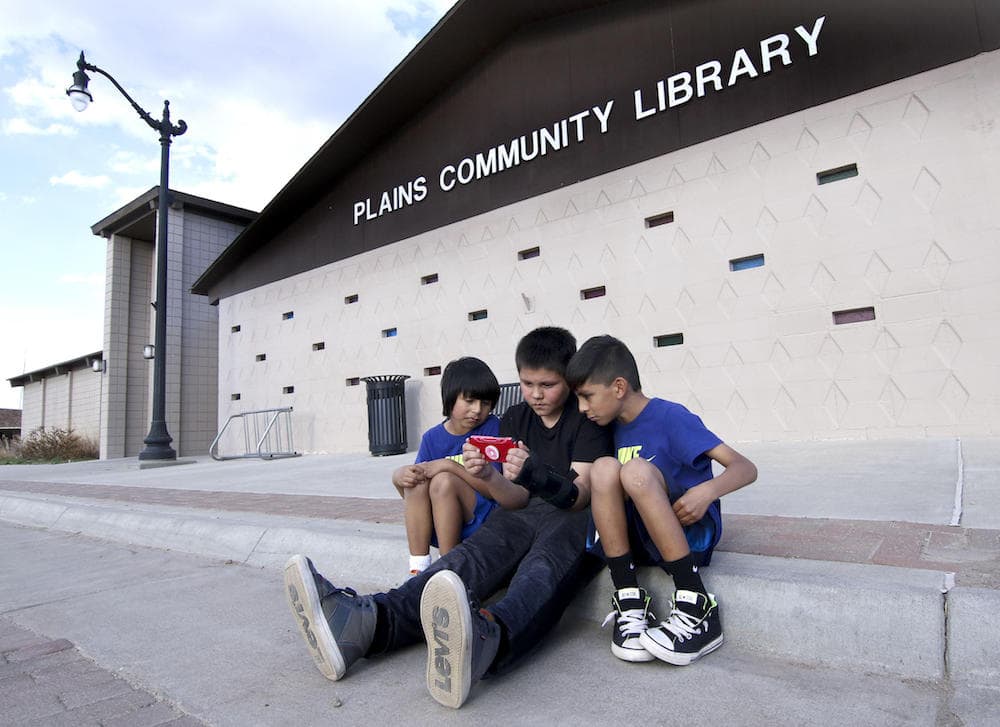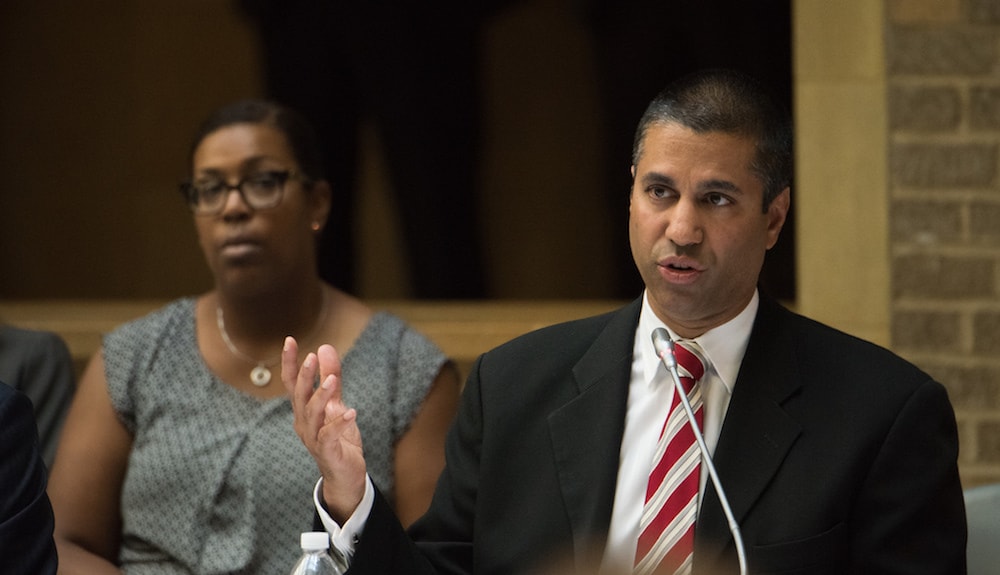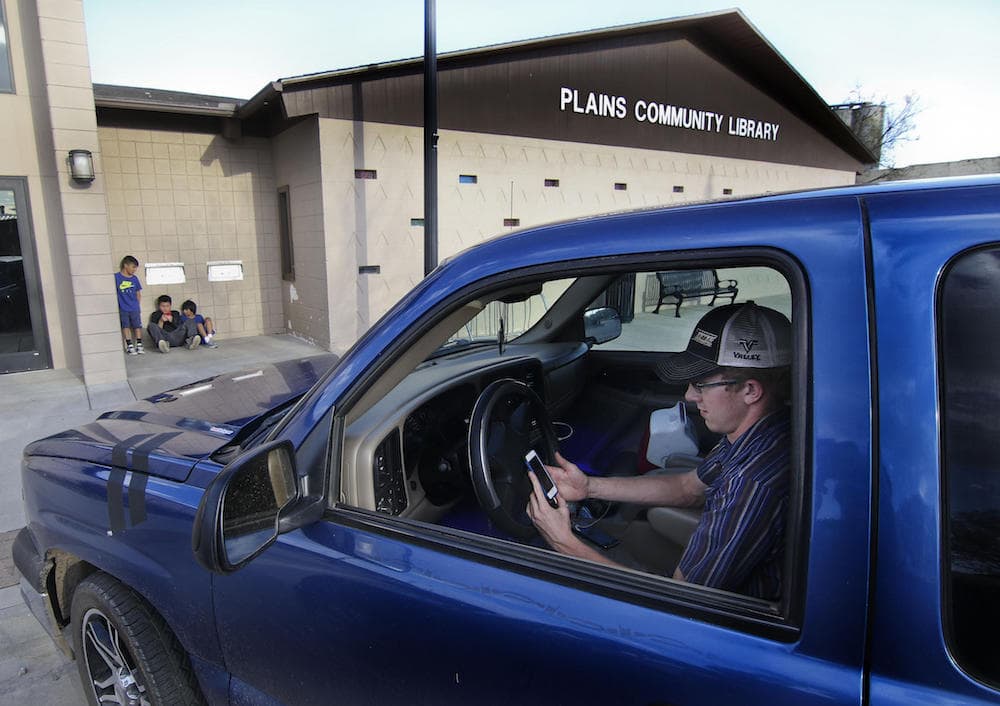What Net Neutrality Could Mean For Slow Internet In Rural Kansas
5:23 minutes

 This segment is part of The State of Science, a series featuring science stories from public radio stations across the United States. A version of this story, by Ben Kuebrich, originally appeared on Kansas News Service, a collaboration covering health, education, and politics across the state.
This segment is part of The State of Science, a series featuring science stories from public radio stations across the United States. A version of this story, by Ben Kuebrich, originally appeared on Kansas News Service, a collaboration covering health, education, and politics across the state.
Ashley Leal parks in front of the Plains, Kansas, Community Library. It’s about to close, but she doesn’t care. She pulls out her blue laptop.
“I’m … using the Wi-Fi,” Leal says with a laugh.
Her home internet was so slow, she came to the library parking lot. Cars often idle there in the evening while their drivers tap into a plodding, but treasured, link to the internet.
“I’m just thankful that we have somewhere to go,” Leal says.
It’s the only free internet in this small western Kansas town. For many people, it’s the only internet, period. Surprisingly, part of the problem and the solution, for rural areas may lie in Netflix traffic.
While 10 percent of Americans had no access to broadband in 2016, that number was nearly 40 percent in rural areas.
The more remote you are, the more critical the connection to the rest of the world. But the Federal Communications Commission says while 10 percent of Americans had no access to broadband in 2016, that number was nearly 40 percent in rural areas.
In the Digital Age, bandwidth influences where businesses locate, which towns young people settle down in or flee, and whether the growing ranks of rural elderly can stay by using long-distance health care. It’s how people apply for jobs, how children tackle their homework, how friends and family stay in touch.

But broadband becomes more expensive as it strains to reach distant and sparsely populated areas. It just takes more cable, utility poles or even cell towers to carry all those ones and zeros longer distances. Yet the costs are split between fewer people than in cities or suburbs.
Phone and cable companies have been reluctant to spend so much money to reach so few customers. That’s why some analysts are dubious that the private sector will solve the rural broadband shortage.
[Meet the researchers concocting Category 5 hurricanes… in a box.]
The challenges of providing rural broadband echo efforts in the last century to make telephone service nearly universal. To achieve that, Americans taxed phone bills to underwrite the steep cost of stringing copper wires out to rural customers.
So should city dwellers chip in again to make sure everybody can hunt for work online and stream Netflix?
Or should part of that bill be paid by companies that do business over the internet, the way truckers pay for roads through tolls and fuel taxes? Companies such as, say, Netflix? The video-streaming platform consumes nearly half the bandwidth of some rural communities, effectively cutting peak internet speeds by 50 percent for everyone in the area.
Some people wrestling with ways to wire rural Kansas, and similar areas across the country, say a Trump-era change in regulation could either solve the problem or make things worse.
During the Bush and Obama years, net neutrality governed the internet. It insisted that all online traffic move with the same priority—whether it’s a video of an infant shared with Grandma or an episode of “Stranger Things” streaming to millions.
That all-data-is-equal mantra aimed to allow innovation by preventing corporate giants from muscling out start-ups or yet-to-be-imagined internet applications.
Now the FCC under the Trump administration has dumped net neutrality, allowing fast lanes on the information superhighway for companies willing to pay a premium. Some of the new rules began to take effect this week.
Some people, including firms that sell internet service in small towns, think those tollways could help bring robust broadband to places like Plains. Others suggest taxing Netflix and other big bandwidth users to build more bandwidth where it’s most scarce.
At stake is whether remote towns in Kansas and elsewhere will find themselves on the wrong side of the digital divide.
“Not everybody wants to live in a city. But they still want Internet.”
“Just like you would say it would be crazy for somebody to live without electricity, it would be crazy for somebody to live without internet,” said Dan Wallach, a computer science professor at Rice University. “That’s just how the world works now. … Not everybody has the kind of job that would bring them to the city, not everybody wants to live in a city. But they still want Internet.”
When the FCC wiped away net neutrality rules last December, commission chairman Ajit Pai characterized the decision as a rollback of a 2015 Obama-era regulation that he said had hurt infrastructure investment.
[Keep calm, and hunt for gravitational lenses.]

“What is responsible for the phenomenal development of the Internet? It certainly wasn’t heavy-handed government regulation,” Pai, who grew up in Parsons, Kansas, said in a statement at the time.
Rather, he argued that “heavy-handed micromanagement” had discouraged private investment in rural areas.
But John Peha said the FCC action erased over a decade’s worth of thinking about how to regulate the internet. He’s a Carnegie Mellon University professor of engineering and public policy and was chief technologist at the FCC for some of the Obama years.
Pai had noted that internet infrastructure investment dipped in 2015. He attributed the drop to over-regulation. Peha had a different analysis. He noted that Comcast, for instance, told shareholders at the time that net neutrality hadn’t influenced its business decisions.
“What these companies have said, not to the FCC but to their shareholders—in legally-binding language—they have said net neutrality regulations did not impede their investment,” Peha said.
Catherine Moyer, CEO of the nonprofit Pioneer Communications in Ulysses, Kansas, said net neutrality hadn’t thwarted her company’s infrastructure spending, either. Rather, she said the broadband investment drop in 2015 was likely due to uncertainty about internet infrastructure subsidies.
The Universal Service Fund charge on most phone bills was set up to subsidize phone service for the poor and for high-cost, usually rural, areas. Now some of that money also goes toward internet service. For example, those taxes support the federal E-Rate program to subsidize internet costs for schools and libraries. As of 2013, another portion was diverted into the Connect America Fund to be spent on information infrastructure in places where it was lacking.
Moyer said that in 2015 banks were reluctant to lend money to rural internet service providers, or ISPs, out of fear that the subsidies might disappear. Without government spending to help internet infrastructure construction, she said, the banks worried ISPs would struggle to repay loans.
In March, the FCC authorized an added $540 million to help phone and cable companies wire costly-to-service places. But a study released earlier this year found the cost of just connecting schools, libraries and health providers—but not homes—in the country would cost nearly $20 billion.
Moyer said now that net neutrality rules have gone away, there’s a chance to bargain with Netflix and other companies looking to spare their customers the purgatory of buffering.
More than half of Pioneer’s traffic is now streaming video. Netflix alone accounts for 42 percent. That’s clogging Pioneer’s network.
“If we were to say, ‘We’ll prioritize your traffic, Netflix, if you pay us ‘X’ dollars per month,’ that’d be great,” Moyer said.
As a co-op, Moyer says, Pioneer would invest any extra money into infrastructure. That would bolster Pai’s argument that deregulation could build a better internet.
Currently, she said, Netflix is driving the need for Pioneer to upgrade. But the streaming service doesn’t pay Pioneer a dime.
When Netflix sends a bit of data to one of Pioneer’s customers, the company pays a local ISP where its computer servers operate to steer its traffic onto the so-called backbone of the internet. A backbone provider moves that data over to Pioneer’s network. The Netflix customer pays Pioneer for the final delivery to the home.
On small-town streets, most traffic comes from local drivers who are all paying for the roads. Yet almost half of the traffic and congestion on Pioneer’s local network comes from a single company—Netflix—that doesn’t pay for local infrastructure. While Netflix pays an ISP for the first part of its journey, it pays nothing to the ISPs at the other end.
Ditching net neutrality might let Pioneer charge Netflix a toll to use its local roads—and create the income needed to keep those roads capable of handling heavier traffic.
But an end to net neutrality, basically a change in traffic rules, might fundamentally change internet dynamics. With that regulation gone, critics worry ISPs will use the power to squash competition by deciding differing prices for different traffic.
Some analysts argue that Netflix, for example, might never have taken off without net neutrality. Cable companies might have seen it as a threat to the channels they sell and demanded prohibitive fees for carrying the service. Internet providers that were also selling phone service might have felt similarly threatened by Skype. Those analysts worry that the loss of net neutrality may block out future internet innovations as well.
Companies still might conclude it’s not worth the cost of paying a toll to reach tiny markets like those in western Kansas.
Meanwhile, ideas are circulating about other ways to scratch together money for a better rural internet.
Kansas state Sen. Tom Sloan proposed a bill in February that would tax companies such as Netflix and funnel the revenue into a rural broadband fund. Yet there’s some debate over whether Kansas could enforce the tax. Federal statutes only allow states to tax intrastate telecommunications. Services such as Netflix operate between states.
Sloan’s bill has stalled in committee. Instead, lawmakers are dispatching a task force to study rural broadband.
Or small cities and towns can build their own services.
“Municipalities are perfectly positioned to go and build these systems and be patient.”
“It’s a very straightforward, boring utility business,” Montgomery said, a co-founder of Wicked Broadband in Lawrence. “Municipalities are perfectly positioned to go and build these systems and be patient.”
Still, the idea of publicly owned internet services has sometimes proved daunting.
Chanute, a town of 9,000 people in southeast Kansas, explored the idea of tapping into a network at the local community college. But the plan stalled when the city couldn’t raise enough money. Ottawa, Kansas, lets business tap into their municipal network but decided it would be too expensive for residential customers.
Critics worry that municipal ISPs will pose unfair competition to private services—and discourage commercial investment.
Wireless technology may offer some hope. As 5G cellphone technology comes online over the next decade, wireless speeds could quickly leapfrog past the current wired options in rural areas.
That’s a hope for reaching remote areas, but not a quick fix. Companies will likely remain reluctant to spend in places with the least customers—even 3G proves elusive in rural areas.
Meanwhile, Cable companies have begun to toy with fixed wireless technology that would beam a high-speed signal directly to a home—reducing some of the steep costs of burying cables or stringing them on utility poles. Tech mogul Elon Musk has plans for a network of low-flying satellites that would provide basic internet to even the most remote ranches.
Ultimately, though, wireless will hit a limit.
“There’s a certain amount of bandwidth they’ve got in in the sky. And once it’s full you can’t push any more bits,” said Wallach, the Rice University computer scientist. “With wires, you can always run another wire.”
Finally, price is a problem. In Plains, Kansas, the problems double up. Internet connections aren’t just slower, they’re costlier.
Service through AT&T runs $61 per month, and its advertised speed is more than 150 times slower than what multiple companies sell in Kansas City for around the same price.

So, in Plains, people often turn to the library. Patrons connected to the library Wi-Fi around 28,000 times last year. Barely 1,000 people live in Plains.
Libraries across the U.S. have quietly served as a de facto safety net for internet connections since the days of dial-up. First, they offered computer terminals and later added Wi-Fi. Now some libraries in Kansas even lend patrons portable hotspots to bring the Web home.
“One of the big pushes across the country has been to put a laptop or tablet in every child’s hand,” said Steve Andrews, a system administrator for the Southwest Kansas Library System that supports 30 libraries. “People fail to realize that child might not have Internet access at home.”
Rural libraries pay for their internet connections, like schools, largely through the federal E-Rate program. Without that money, Andrews said, library internet could easily go away.
And libraries can only share as much internet much internet as they can tap into.
At best, the Plains Community Library only gets up to 6 megabits per second for download speeds to share among its patrons. That’s less than a quarter the speeds required for the FCC’s definition for broadband — and far more sluggish than what most people have piped to their homes in Johnson County or Wichita.
On a busy day, that single connection in the library may be split a dozen ways.
But as slow as the connection in Plains parking lot is, Leal said she isn’t sure what she’d do without it.
“I guess,” she said, “go to a farther town and go to another library.”
Ben Kuebrich reports for High Plains Public Radio in Garden City and the Kansas News Service, a collaboration of KMUW, Kansas Public Radio, KCUR and HPPR covering health, education and politics. Follow him on @Ben_Kuebrich. Kansas News Service stories and photos may be republished at no cost with proper attribution and a link back to the original post.
Ben Kuebrich is a reporter with Kansas News Service and High Plains Public Radio, based in Garden City, Kansas.
[DIFFERENT RADIO STATIONS ID THEMSELVES]
Local science stories with national impact. Earlier this year, the Federal Communications Commission voted to end rules ensuring net neutrality, which prohibit internet service providers from privileging some content over others. There were millions of public comments in opposition to end net neutrality, but Commissioner Agit Pai said doing so could be a boon for rural America, where internet access and broadband speeds continued to lag.
Well, my next guest wanted to find out if this was true in his state of Kansas. Could the absence of net neutrality benefit rural customers and allow ISPs to expand service? And here with that story is Ben Kuebrich, a reporter for a Kansas News Service and High Plains Public Radio. He joins us from Garden City, Kansas, and you can read his reporting on our website at sciencefriday.com/broadband. Welcome, Ben.
BEN KUEBRICH: Hey, how’s it going?
IRA FLATOW: So what’s it like for people trying to use the internet in rural Kansas? Give us an idea.
BEN KUEBRICH: Yeah, so I sought to answer that question that you just brought up, of what does net neutrality have to do with rural broadband? So I went down to this small town, Ulysses, Kansas, and I talked to Catherine Moyer there. She’s the CEO of Pioneer Communications, which is like a local nonprofit ISP there. And I asked her, I said, Agit Pai is making this case. Is there anything to it?
And she told me this really shocking number. So she told me 42% of their network’s bandwidth is going towards a single company, and that’s Netflix. So it’s people streaming videos on Netflix. And she said, you know, one of the things that net neutrality lets us do is potentially, we can go to Netflix now, and we can say, if we give you x dollars a month to prioritize your traffic, potentially they can get some money that they can reinvest back in their network. It’s a win for Netflix, and it’s a win for people watching Netflix as well.
IRA FLATOW: But what about the ISPs though? What kind of service are they providing? Is it high speed? Is it high band? What’s going on for the average user?
BEN KUEBRICH: Yeah, yeah, so one of the other places I went– I went down to Plains, Kansas, and there, if you go to the library, you have people sitting in their cars all times of day, all times of night, using the library Wi-Fi, because just the service there is just bad. And according to the FCC, 40% of rural America doesn’t have access to high speed internet. And the FCC defines that as 25 megabits per second down and three megabits per second up.
So we know that we’ve had this big problem of trying to get broadband out to rural America, and the debate is how we fix that.
IRA FLATOW: So do you get the impression that it is being fixed for all of these rural residents?
BEN KUEBRICH: Well, so I think we’re slowly making steps in the right direction. One of the struggles with internet is we’re going to have to continually upgrade it so that people, year after year, are demanding more and more data. So we’ve had this same problem with rural electrification and with rural telephony of getting connections out to people’s houses. But it’s a little bit different with internet, because over time, we keep wanting more and more internet.
So I think we are making some steps in the right direction. So the Kansas legislature, they decided to make this task force where they’re going to investigate different ways to fund rural broadband and also do a comprehensive study to really look at what the speeds are across the state and what we can do, what places need the most investment. Because actually, there’s not that good of data out there right now.
IRA FLATOW: So this has become a political issue, then, in Kansas, or at least the parts that you’ve looked into that they feel the heat from the public and they’re going to decide that they’d better do something about it?
BEN KUEBRICH: Yeah, I think really internet is a need now, that the way– this guy I talked to I think put it really well, where he said if someone was living without electricity right now, you’d think they’re crazy or something. And we’ve kind of gotten to that point with the internet, where maybe there’s government forms that you can only fill out online or for your kids to do their homework, they’ve got to be Googling stuff and looking it up. So internet has really become a need, but we haven’t figured out a way to make sure that everyone has access to internet. And it is more expensive to bring internet out to these rural places. It just takes more cable to get it there.
IRA FLATOW: All right, Ben. Ben Kuebrich, reporter for Kansas News Service High Plains Public Radio from Garden City, Kansas. Thank you for joining us today.
Christie Taylor was a producer for Science Friday. Her days involved diligent research, too many phone calls for an introvert, and asking scientists if they have any audio of that narwhal heartbeat.